The Art of Customer Retention: Strategies, Tips, and Best Practices
As customer acquisition gets increasingly expensive, brands are looking to lower costs and boost revenue by building loyalty via customer retention
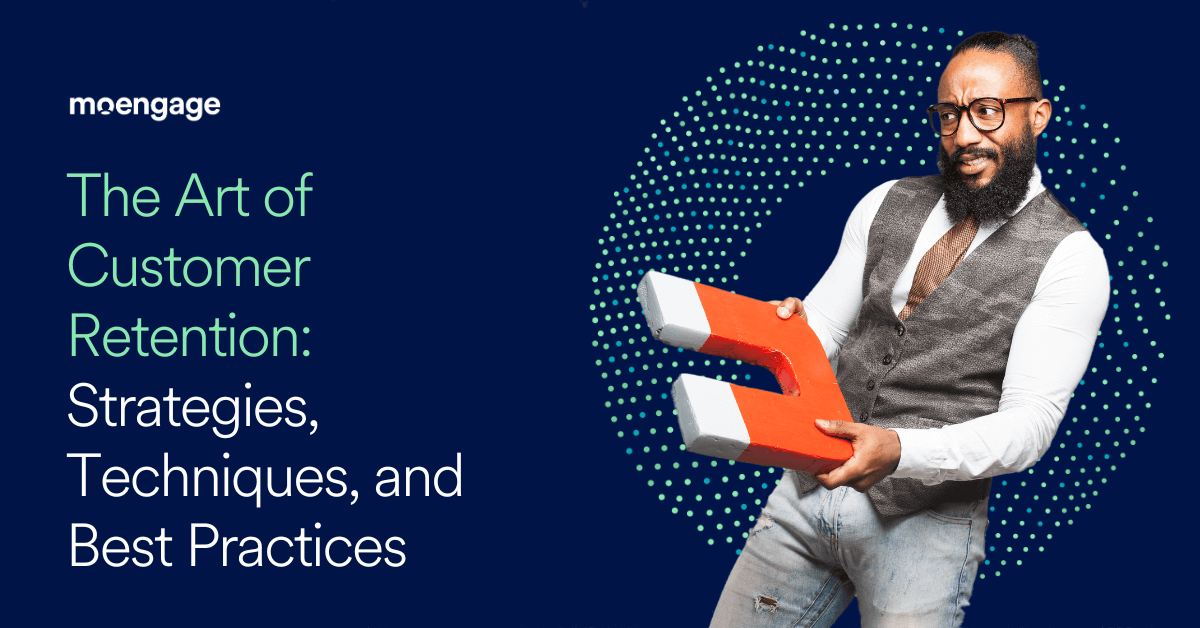
Reading Time: 15 minutes
Introduction
“Is Customer Retention Important?”
Imagine you have two favorite coffee shops near your home: Both serve excellent coffee, but their approaches to customer retention are quite distinct.
At Coffee Shop A, the baristas know you by name, remember your usual order, and greet you with a warm smile every time you visit. They take the time to engage in friendly conversations and create a comfortable environment where you feel valued as a customer.
On the other hand, Coffee Shop B focuses on attracting new customers through frequent promotions and discounts. While the coffee is just as good, you don’t feel the same personal touch as you do at Coffee Shop A. Each visit feels transactional, and there is little effort to build a lasting relationship beyond the initial purchase.
Now, let’s fast forward a few months. Coffee Shop A continues to provide exceptional service and maintains that personal connection with you. You feel like a part of their coffee-loving family, and you recommend the place to friends and colleagues. They, too, become regular patrons and enjoy the same personalized treatment.
Meanwhile, Coffee Shop B is constantly investing in acquiring new customers. Their promotions may initially attract consumers, but many never return after the one-time discount. While they have a steady stream of new faces, they struggle to build a loyal customer base.
One day, Coffee Shop A introduces a loyalty program for their regular customers. They offer exclusive discounts, free upgrades, and even invite you to a coffee-tasting event. This gesture deepens your loyalty, and you feel appreciated for your continued support.
At this point, you rarely visit Coffee Shop B, as the lack of a personalized experience and loyalty rewards make you feel like just another customer in the crowd. Your loyalty lies with Coffee Shop A, where you not only enjoy great coffee but also feel valued and part of a coffee-loving community.
Similarly, in business, focusing on customer retention by nurturing relationships, providing personalized experiences, and offering loyalty rewards fosters a loyal customer base, positive word-of-mouth, and long-term success.
In this blog, we will explore the significance of customer retention, its impact on Customer Lifetime Value (CLV), and how businesses can employ effective strategies and techniques to ensure long-term customer success.
A. The Importance of Customer Retention
Simply put, customer retention matters! Retaining customers becomes even more crucial when competition is intense. Businesses that invest in customer retention see significant improvements in their bottom line, with a higher CLV leading to increased profitability.
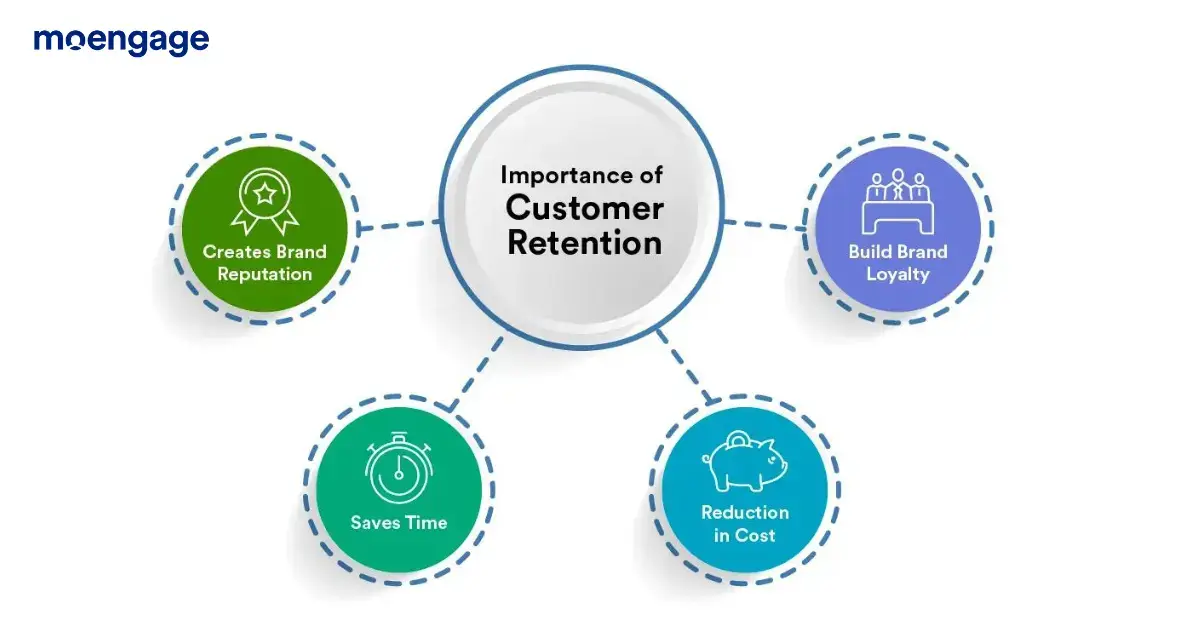
B. The Significance of Customer Lifetime Value (CLV)
Customer Lifetime Value (CLV) is a critical metric that quantifies the total revenue a customer generates throughout their association with a brand. Studies have shown that improving retention rates can exponentially increase CLV, indicating the immense value of loyal customers to a company’s long-term success.
A prime example of this can be observed in the E-commerce sector. E-commerce platforms have witnessed a surge in customer acquisition. However, the real challenge lies in retaining current customers beyond their initial purchase.
By implementing effective customer retention strategies, such as personalized recommendations and timely communication, E-commerce companies can boost CLV and achieve sustainable growth.
| Also Read: How Lifestyle improved customer retention by 30% |
Understanding Customer Retention
A. Definition of Customer Retention and Its Impact
Customer retention refers to the process of keeping existing customers engaged, satisfied, and loyal to a brand over time. It involves a comprehensive approach that focuses on understanding customer needs, delivering exceptional experiences, and building lasting connections.
Is customer retention important for brands?
For businesses, customer retention is paramount as it leads to reduced churn, increased CLV, and a steady revenue stream. In fact, increasing customer retention rates by 5% increases profits by 25% to 95%, according to research done by Frederick Reichheld of Bain & Company.
B. The Relationship Between Retaining Existing Customers and Acquisition
Customer retention and acquisition are complementary strategies. While acquisition brings in new customers, a customer retention strategy focuses on nurturing and retaining existing customers, both working together to create a thriving customer base. Businesses need to strike a balance between acquiring new customers and retaining existing ones, as both are essential for sustainable growth.
Businesses in the region that allocate resources to both customer acquisition and retention achieve higher customer lifetime value, demonstrating the importance of a holistic approach. In addition to improving retention, brands must also actively seek to lower customer acquisition costs.
C. The Customer Retention Funnel
The customer retention funnel outlines the customer journey from the initial purchase to becoming a loyal advocate. It involves stages such as activation, engagement, conversion, and loyalty, which businesses can optimize to increase customer retention rate.
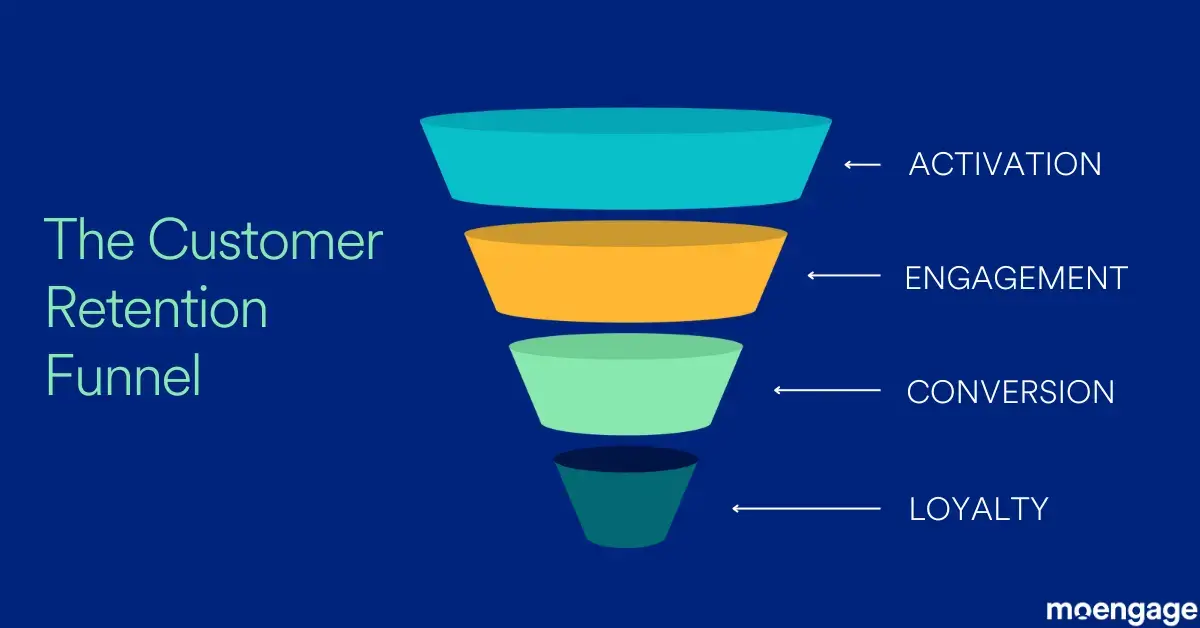
1. Activation
The activation stage focuses on ensuring customers have a positive onboarding experience. By providing a smooth and seamless onboarding process, businesses can set the foundation for a long-lasting relationship.
2. Engagement
Engaging customers through regular touchpoints and personalized communication helps businesses maintain their interest and attention. This stage is crucial in building emotional connections with customers.
3. Conversion
Conversion refers to the stage where customers become repeat buyers. Businesses can encourage these repeat customer purchases through loyalty programs, personalized offers, and excellent customer service.
4. Loyalty
The final stage of the retention funnel involves fostering loyalty and advocacy among customers acquired before. Satisfied and the most loyal customers become brand advocates, driving word-of-mouth marketing and contributing to new customer acquisition. This can also be facilitated by exceptional customer retention programs.
D. Key Metrics for Measuring Customer Retention
To assess customer retention efforts, businesses can use several key metrics that provide valuable insights into their performance:
1. Customer Churn Rate
The churn rate measures the percentage of customers who stop using a product or subscription service, during a specific period. A high churn rate indicates that a number of customers are not finding value in the offering, emphasizing the need for improved retention strategies.
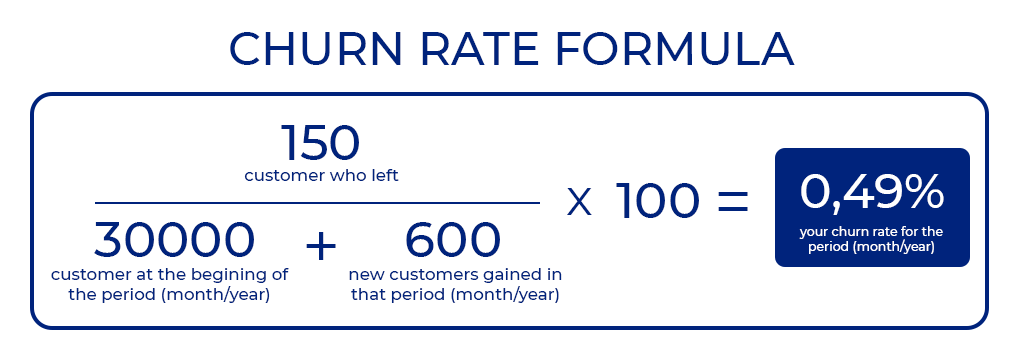
2. Customer Lifetime Value (CLV)
CLV quantifies the total revenue a customer generates throughout their association with a brand. A higher CLV reflects better customer retention and loyalty.

3. Customer Retention Rate
The customer retention rate measures the percentage number of customers retained over a specific period. A higher retention rate indicates successful customer retention efforts. Here’s how you measure customer retention rate:

4. Repeat Purchase Rate
This metric calculates the percentage of customers who make multiple purchases over a specific period. A high repeat purchase rate indicates strong customer loyalty.

Analyzing the Benefits of Customer Retention
A. Cost Savings and Increased Profits
Customer retention is a cost-effective approach compared to customer acquisition. Acquiring new customers can be five times more expensive than retaining existing ones. When businesses increase customer retention, they can save on marketing expenses and achieve a higher return on investment.
Furthermore, existing customers tend to spend more on products and services over time. A robust Customer Engagement Platform makes it simple and easy to analyze customer behavior and affinities and empower them to purchase more products and services. This can improve not just the retention rate but also saves costs, increase profits, engagement, and conversions.
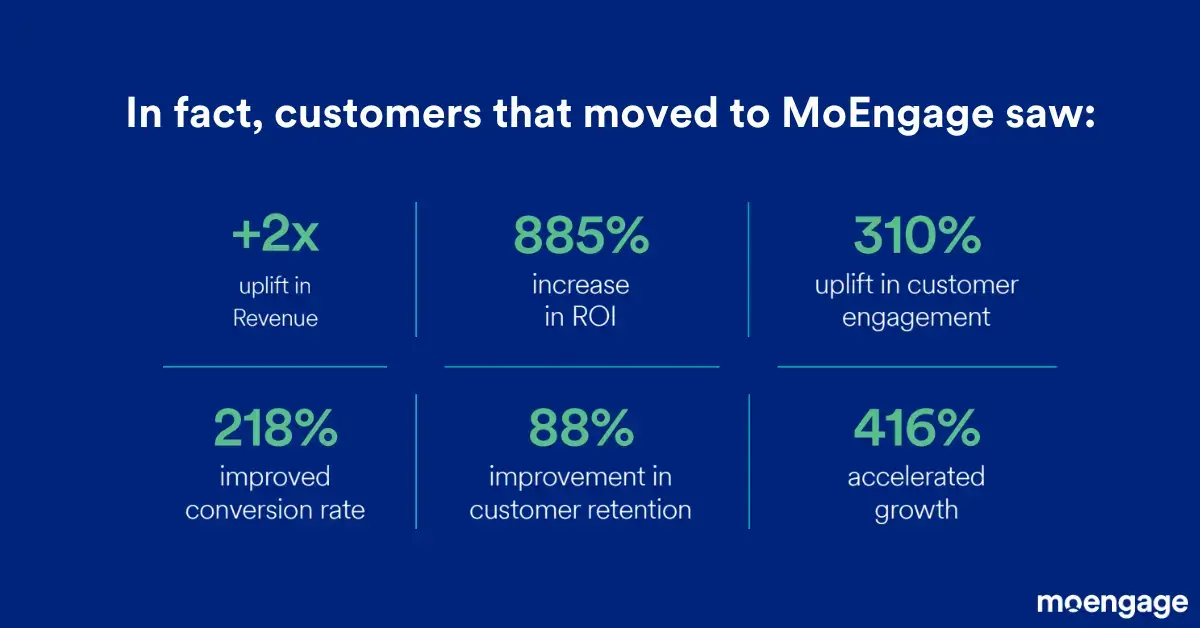
B. Enhanced Customer Loyalty and Advocacy
Loyal customers are not just repeat buyers; they become brand advocates. Satisfied customers are more likely to recommend a brand to their friends and family, resulting in organic growth through word-of-mouth marketing.
In the digital era, where social media has immense influence, positive customer experiences can have a ripple effect on a brand’s reputation. Customers who have experienced exceptional service tend to share their positive experiences on social media, attracting new customers and boosting brand credibility.
C. Competitive Advantage and Market Differentiation
In highly competitive markets, customer retention can serve as a key differentiator. When businesses consistently deliver value and exceed customers’ expectations, they stand out from competitors.
Moreover, loyal customers are less likely to switch to rival brands, giving businesses a competitive edge. A study by MoEngage found that businesses with a higher customer retention rate experience lower customer churn and can maintain their market position more effectively.
D. Opportunities for Upselling and Cross-selling
Existing customers are more receptive to upselling and cross-selling efforts. They already trust the brand and are more willing to explore additional products or services.
By analyzing customer data and understanding their preferences, businesses can identify upselling and cross-selling opportunities that align with customer needs. 93% of customers are likely to make repeat purchases from brands that offer excellent experiences and services.
Building a Foundation for Customer Retention
A. Creating a Customer-Centric Culture
Building a customer-centric culture is essential for effective customer retention. This culture emphasizes putting the customer at the center of all business decisions, fostering a sense of ownership and responsibility for customer satisfaction among employees.
For instance, an Indonesian banking behemoth, Amar Bank, attributes its success to its customer-centric approach. By ingraining a customer-first mindset across all departments, the company consistently delivers outstanding experiences.
| Also Read: 5 Bank Marketing Strategies that Can Enhance the Online Banking Experience |
B. Establishing Clear Value Propositions
Clearly communicating the unique value propositions of products/services builds trust and helps customers understand how they can benefit from their association with the brand.
In the E-commerce sector, Flipkart Shopsy, stands out by emphasizing its personalized product offerings, accurate customer segmentation, and superior customer service. By articulating its value propositions effectively, the E-commerce giant has built a loyal customer base, with a 4x uplift in conversions and a 2x uplift in retention.
C. Setting Realistic Customer Expectations
Avoiding over-promising and under-delivering is crucial. Setting realistic expectations helps prevent customer disappointment and fosters a more positive customer experience. Therefore, one must also work on managing expectations to ensure customers do not develop a distrust for brands. Offering onboarding assistance, fast-tracking the processing of rewards from loyalty programs, etc., can go a long way in building trust.
D. Delivering Exceptional Customer Service
Outstanding customer service is the backbone of any retention strategy. Your customer service team must resolve queries promptly and efficiently, ensuring customers feel valued and cared for. 24/7 availability, easy navigation to seek support, and immediate redressals across platforms/channels like social media, WhatsApp, chatbots, etc., are some great ways to deliver excellent customer service.
Strategies for Customer Retention
A. Personalization and Customization
1. Analyzing and Utilizing Customer Data
Gathering customer data, such as preferences, behavior, and purchase history, from multiple platforms and sources enables businesses to personalize interactions and offers.
2. Tailoring Products/Services to Individual Customer Needs
Using customer data, businesses can create personalized product recommendations, leading to higher satisfaction and retention rates.

Online streaming platforms, such as Netflix, Hulu, POPS Worldwide, and Disney+, use advanced algorithms to analyze viewers’ watching habits and preferences. By suggesting content that aligns with individual tastes, the platform keeps customers engaged, leading to increased customer retention.
B. Proactive Communication and Engagement
1. Effective Communication Channels
Engaging customers through preferred communication channels, such as email, social media, or in-app messaging, ensures timely and relevant interactions.
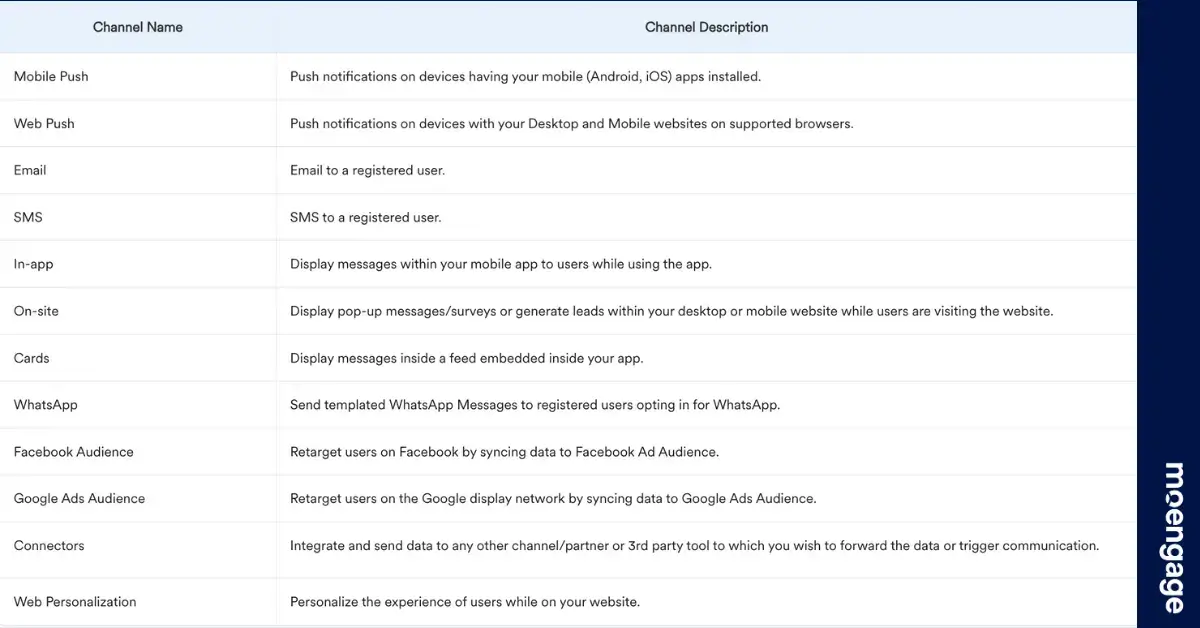
| Also Read: 4 App Retention Strategies for Retail and D2C |
2. Regular Touchpoints and Relationship Building
Consistent communication, including personalized follow-ups, nurtures great customer service relationships and keeps the brand recall high, thereby improving customer retention rate.
Telekom Malaysia, a telecommunications provider and market leader in Malaysia, emphasizes regular touchpoints with its customers. The company sends personalized greetings on special occasions, provides timely updates on new services, and seeks feedback to improve its offerings. By prioritizing the experience of their current and prospective customers, Telekom Malaysia has achieved high customer loyalty and retention.
C. Loyalty Programs and Rewards
1. Types of Loyalty Programs:
Implementing tiered loyalty programs, points-based rewards, or exclusive member benefits incentivizes repeat purchases and loyalty.
An example of this customer retention strategy can be seen in Spencer’s, a grocery chain. The company offers a tiered loyalty program, where customers earn points for every purchase. As customers move up the loyalty tiers, they gain access to exclusive discounts and offers, encouraging them to make repeat purchases and remain loyal to the brand.
2. Designing Effective Rewards Systems
Tailoring rewards to customer preferences and behavior encourages greater participation in loyalty programs and strengthens retention.
A leading food delivery platform, Swiggy, uses insights-led customer retention strategies to design rewards that resonate with its customers. By analyzing their ordering habits and the customer location, the platform offers personalized discounts and freebies, making customers feel valued and motivated to order repeatedly.
D. Continuous Improvement and Innovation
1. Monitoring and Acting on Customer Feedback
Regularly seeking and acting on feedback helps identify pain points and areas for improvement, leading to better customer experiences. Ensure you consistently collect customer feedback and create an end-to-end customer feedback loop.
2. Anticipating and Addressing Changing Customer Needs
Staying ahead of customer preferences and market trends allows businesses to proactively adapt their offerings and meet evolving demands.
A prime example of this can be Tesla, a technology and automotive company. By keeping a close eye on technological advancements and expectations, the company constantly innovates and updates its products, retaining a loyal customer base. Additionally, with new applications for Artificial Intelligence across industries being built every single day, companies are set to leverage its efficiency and accuracy to appease customers.
Techniques and Tips for Customer Retention
A. Onboarding and First Impressions
1. The Importance of a Smooth Onboarding Process
A seamless onboarding experience sets the tone for the entire customer journey, influencing long-term customer satisfaction and improvement in retention.
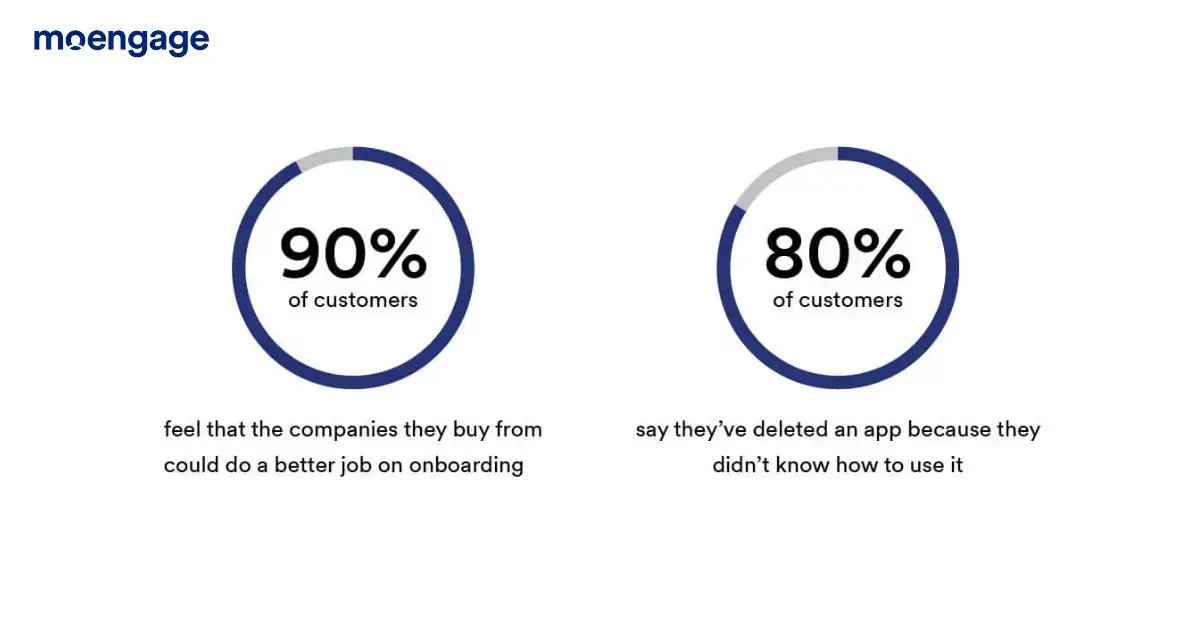
2. Creating Positive First Experiences
Delighting customers during their initial interactions establishes a strong foundation for future loyalty. This, in turn, helps build a great customer experience.
B. Relationship Management and Personal Connections
1. Assigning Dedicated Account Managers
Personalized support from dedicated account managers strengthens customer relationships and fosters trust.
In the B2B sector, software providers assign dedicated account managers to each client. These account managers build personal connections with clients, ensuring that their needs are met promptly and effectively, resulting in a high customer retention rate.
2. Building Trust and Rapport
Showing empathy, transparency, and consistent follow-ups build rapport, encourages customers, and deepens the emotional connection with customers.
OYO, an online hotel booking brand, focuses on building trust with its customers. The brand offers flexible booking options, transparent pricing, and clear cancellation policies, instilling confidence in customers and leading to repeat bookings.
C. Customer Education and Support
1. Providing Knowledge Resources and Training
Empowering customers with educational resources and training helps them make the most of the products/services. This could be in the form of newsletters, courses, or a learning hub.
2. Timely and Efficient Customer Support
Offering quick and effective customer support enhances satisfaction and loyalty.
A leading telecommunications provider, Airtel, prides itself on its responsive customer support. The company offers 24/7 support through multiple channels, ensuring that customer queries and issues are addressed promptly, leading to high retention rates.
D. Proactive Churn Prevention
1. Identifying Early Warning Signs of Churn
Using customer data and behavior patterns, businesses can predict potential churn and take preventive measures.
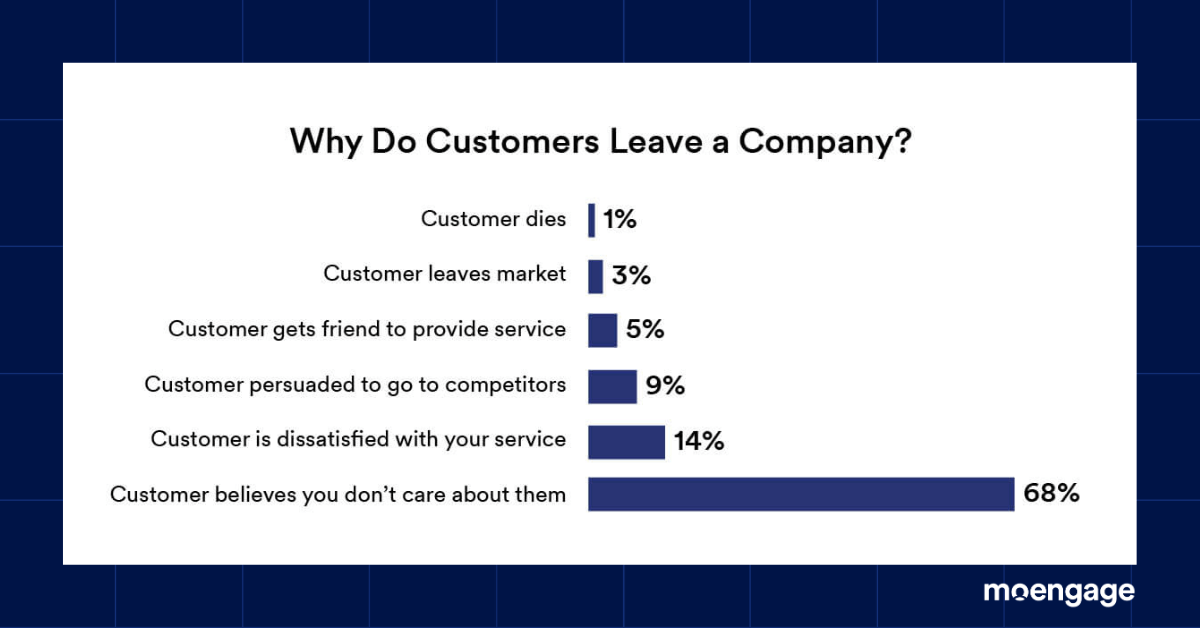
Some companies use customer data to identify signs of potential churn. By analyzing customer engagement levels and purchase patterns, the company proactively reaches out to at-risk customers with personalized offers, reducing churn and improving retention.
2. Targeted Retention Initiatives
Implementing targeted offers or personalized incentives can win back customers who show signs of disengagement.
Financial institutions use targeted retention initiatives to win back lapsed customers. By offering exclusive benefits and incentives to remind customers, the company entices former customers to re-engage with its services, boosting retention.
Best Practices for Customer Retention
A. Implementing a CEP System
Utilizing a Customer Engagement Platform (CEP) system to build a customer retention strategy helps businesses manage customer interactions and analyze retention metrics efficiently.
B. Monitoring and Analyzing Customer Behavior
Continuous monitoring of customer behavior and engagement metrics allows businesses to spot trends and make data-driven decisions.
By analyzing data on customer preferences, browsing habits, and purchase history, companies can identify areas for improvement and tailor their offerings to suit customer needs, enhancing retention.
C. Engaging in Social Listening and Monitoring
Staying attuned to customer sentiment on social media and other online platforms helps businesses address concerns and build a positive brand image.
By monitoring social media conversations and customer reviews, brands can address feedback promptly and demonstrate their commitment to improving customer experiences, ultimately leading to higher retention.
D. Encouraging Customer Feedback and Reviews
Actively seeking customer feedback and encouraging reviews provide valuable insights and demonstrate the brand’s commitment to improvement.
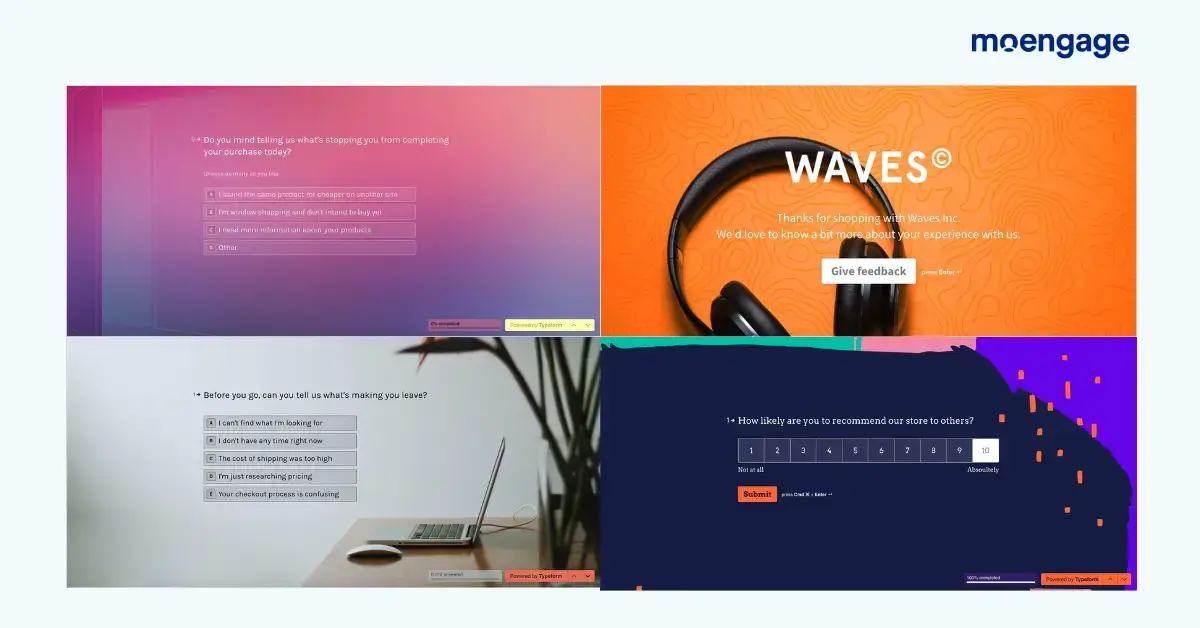
For instance, travel brands regularly seek feedback through post-trip customer surveys. By actively listening to customers and implementing their suggestions, these agencies continuously improve their services, keeping customers happy and increasing satisfaction and loyalty.
Case Studies: Successful Customer Retention Strategies
A. How Mamaearth’s Personalization and Proactive Communication Increased Retention With 26% Boost in Repeat Purchases
Founded in 2016 by husband-wife duo Ghazal Alagh and Varun Alagh, Mamaearth is Asia’s first brand with Made safe certified products that offer toxin-free and natural baby care and personal care products. Driven by innovation and using the best of nature and science, the brand caters to all personal care needs of young, aspirational, and increasingly conscious Indian consumers.
Business Challenge
With limited data access due to data privacy issues that have cropped up in recent years, fewer conversations are made. As a result, the cost of acquiring customers elevates. The advertising prices as well become ineffective due to the return on ad spend reduction.
So, as Mamaearth matured as a brand, there was a need to make a shift from an initial focus on customer acquisition to customer retention. MoEngage helped prove instrumental in executing this at scale.
MoEngage Solution
Mamaearth utilized MoEngage’s Push Amplification® Plus technology to improve its customer reachability and, consequently, increased delivery rates from 26% to 83%. This signifies that there was a ginormous 219% uplift in the delivery rates!
The famed E-commerce brand also created and disseminated a litany of personalized nudges in the form of push notifications using MoEngage by setting up “post-purchase journeys,” and the impact on their clickthrough rates was astounding.
Additionally, using targeted segmentation and hyper-personalization across multiple channels using MoEngage, the Mamaearth team witnessed a significant uplift of 26% in repeat customers!
The Result
Using MoEngage, Mamaearth was able to:
- Clock 219% uplift in the push notification delivery rates
- Observe a 26% increase in repeat customers using segmentation and hyper-personalization
B. How Cake DeFi Uses Omnichannel Strategies to Retain Over 98% of Customers
Cake DeFi is one of Southeast Asia’s fastest-growing digital assets innovators. The Cake DeFi platform provides easy access to decentralized finance (DeFi) services and applications, empowering customers to generate returns on their cryptocurrencies in a secure and transparent way.
Business Challenge
The challenge was to move from disjointed point solutions that lacked omnichannel communications to an all-in-one customer engagement platform.
Solution
Cake DeFi leveraged MoEngage’s customer journey orchestration for email, in-app, and push notification channels to observe a retention rate of over 98%.
The Results
With MoEngage, Cake DeFi adopted an insights-led approach to engagement, leveraging customer journey orchestration and:
- Saw a 200% uplift in account verifications
- Observed a 42.9% boost in conversions for control group user path campaigns
- Increased the retention rate to an all-time high of over 98%
C. How Bella Vita Organic Uplifted Retention Rates by 57% Using Segmentation
Founded in 2012, Bella Vita Organic, or ‘The Good Life,’ is a natural beauty and skincare brand committed to building handcrafted, natural solutions invigorated by the natural elements of the earth and ancient skin and hair care practices.
Business Challenge
With their previous engagement partner, Bella Vita Organic faced significant challenges when it came to the onboarding, integration, and implementation phases. The E-commerce brand was looking for a platform with zero dependencies on its internal tech teams and something that marketers with no coding experience could use seamlessly. The goal was to use the platform to boost customer engagement and revive dormant customers as well. MoEngage bridged that gap and countered those challenges with ease!
MoEngage Solution
With the assistance of MoEngage’s platform, Bella Vita Organic started re-engaging its dormant customers by disseminating nudges through the WhatsApp channel. This initiative led to a 12x jump in Domant Customers Conversions. Additionally, a comprehensive customer segmentation strategy was put in place using RFM (Recency, Frequency, and Monetary score) by MoEngage to boost customer experience, loyalty, and retention.
The Result
Using MoEngage, Bella Vita Organic was able to:
- Clock an uplift of 57% Uplift in retention rates
- Observe a 12x increase in dormant customers conversions
- Uplift Revenue by 94% on their holiday campaigns
Overcoming Challenges in Customer Retention
A. Addressing Customer Dissatisfaction and Complaints
Every business faces customer dissatisfaction and complaints at some point. However, how a business responds to these issues can make a significant difference in customer retention.
B. Dealing with Intense Competition and Price Sensitivity
In highly competitive markets, businesses often face pressure to lower prices to attract and retain customers. However, reducing prices indiscriminately can lead to a decline in profits and compromise the quality of products or services.
C. Adapting to Technological Disruptions and Evolving Customer Expectations
The rapidly evolving technological landscape presents both opportunities and challenges for businesses. Companies that fail to keep pace with technological disruptions risk losing relevance in the market and facing higher customer churn.
Conclusion
A. Summary of Key Points
Customer retention is a crucial business strategy that fosters lasting relationships with existing customers, leading to reduced churn, increased CLV, and sustainable growth. Businesses prioritizing retention benefit from cost savings, increased profits, enhanced customer loyalty, and gain a competitive advantage.
Implementing personalized strategies, proactive communication, a superb customer loyalty program, continuous improvement, and exceptional onboarding experiences are essential elements in building a solid foundation for customer retention. By leveraging best practices, monitoring customer behavior, and actively seeking customer feedback, businesses can create a customer-centric culture and drive success.
B. Emphasizing the Importance of Customer Retention
In an increasingly competitive market, customer retention is a crucial differentiator for businesses. A focus on customer satisfaction, personalized experiences, and innovative strategies is vital for fostering loyalty and advocacy.
| Also Read: The Average Customer Retention Rate by Industry |
C. Call to Action: Implementing Effective Customer Retention Strategies
To thrive in a dynamic market, businesses must embrace cost-effective customer-centric approaches, personalization, and continuous improvement. By adopting data-driven strategies and leveraging Customer Engagement Platforms, businesses can, at any given period, build strong customer relationships, foster loyalty, and achieve sustainable growth through effective retention.
By implementing the strategies, techniques, and best practices outlined in this blog, businesses can navigate challenges, seize opportunities, and make retention a cornerstone of their success in and beyond.
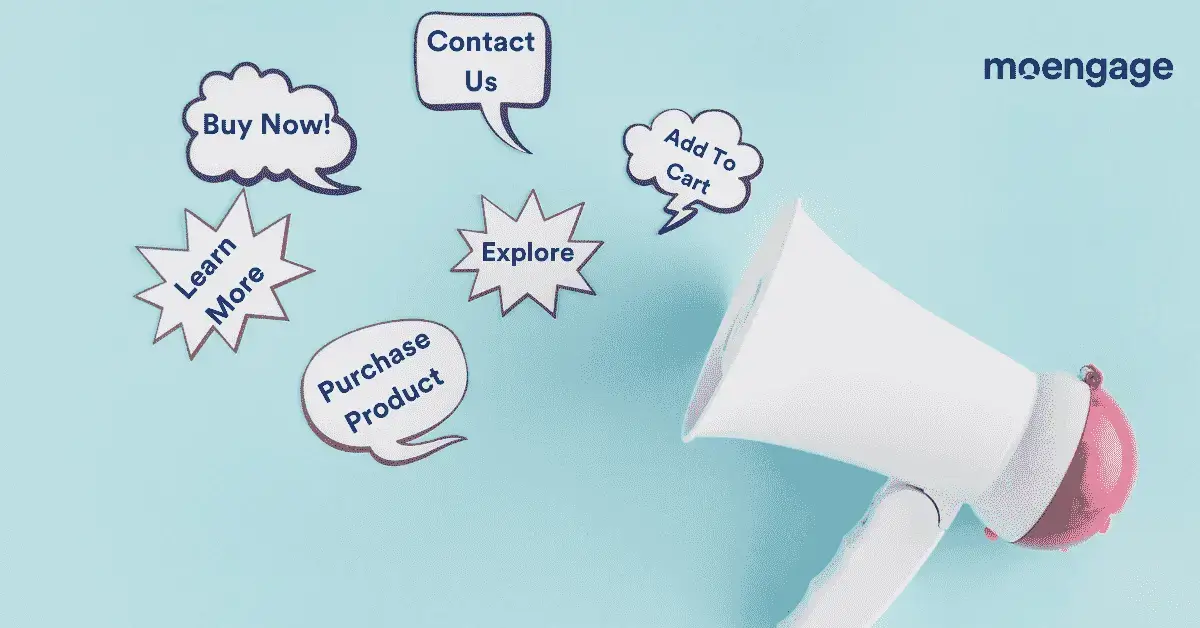
Remember, success in retention requires consistent dedication, continuous innovation, keeping customers invested in your brand, and a relentless pursuit of excellence in customer experiences. The only question you have to ponder over is – “How can I improve my brand’s customer retention?”
Here’s what you can read next: |


















